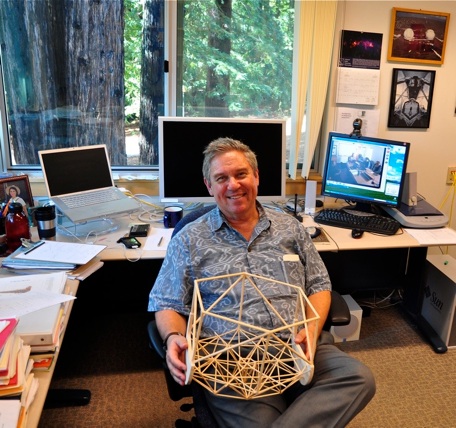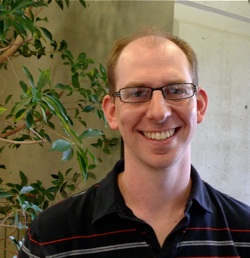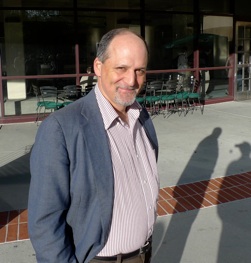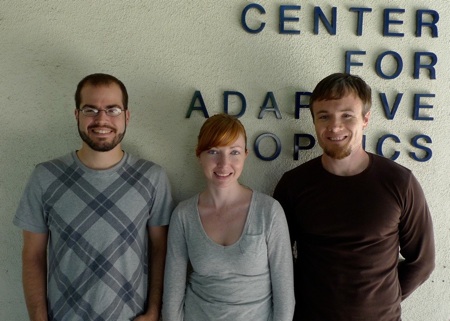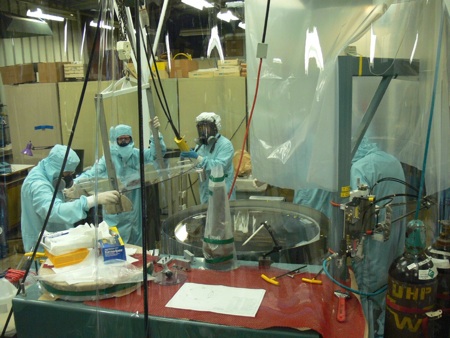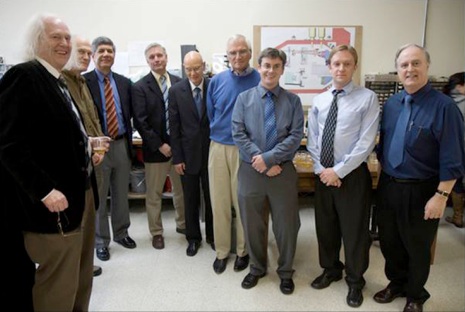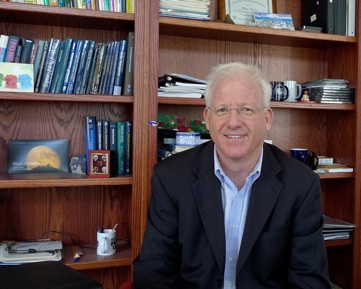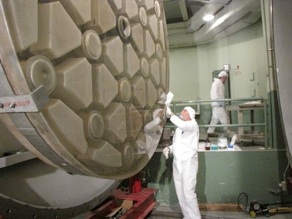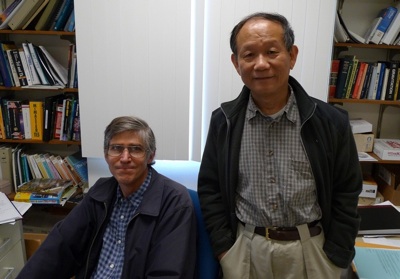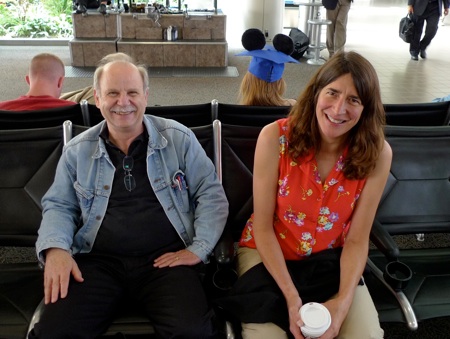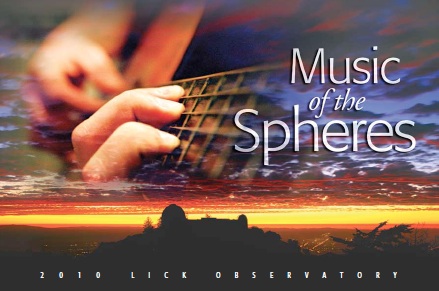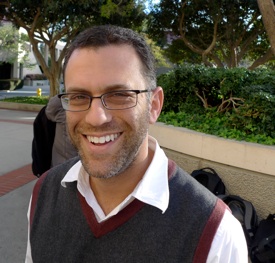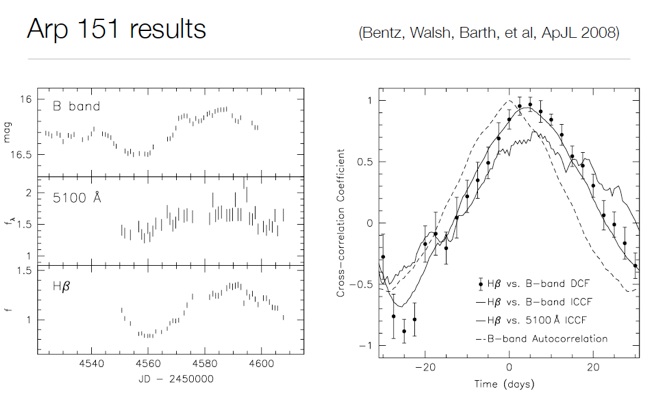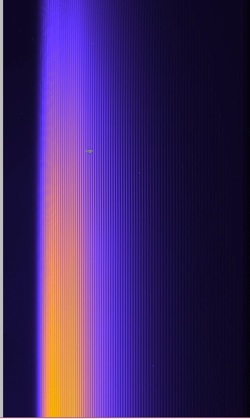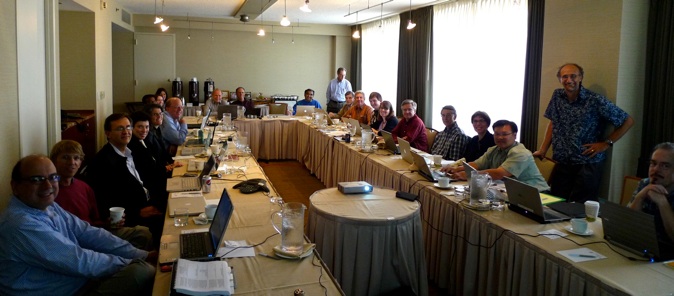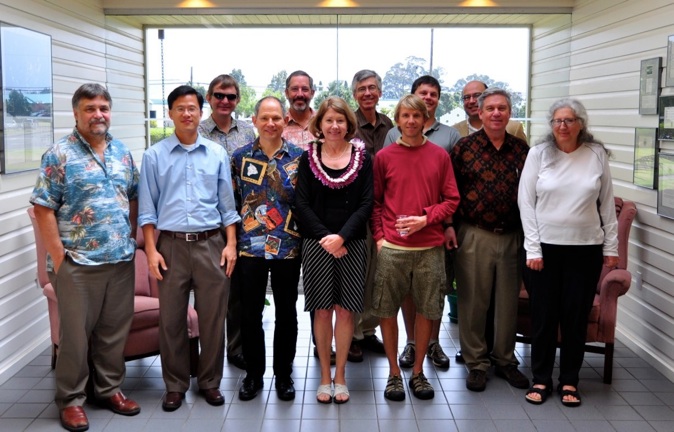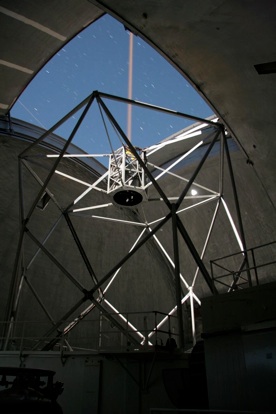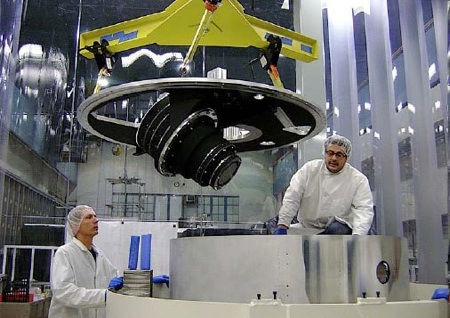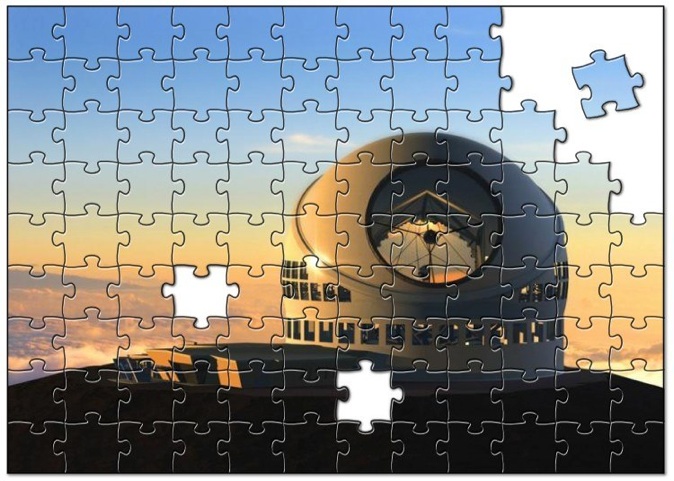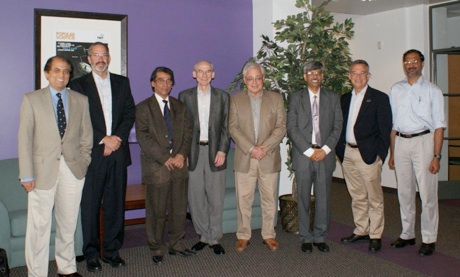AWARDS AND SPECIAL RECOGNITION
CONGRATULATIONS to
Jerry Nelson (UC Santa Cruz) who is a recipient of the 2010 Kavli Prize. This is a great honor and wonderful recognition. The Kavli Prizes are awarded every two years by the Norwegian Academy of Science and
Letters. The laureates will each receive a scroll and gold medal presented by the King of Norway in Oslo, and a share of the $1 million prize. The prize was awarded to Jerry based on the invention of segmented primary mirrors for telescopes. As the UC astronomy community is fortunate to know based on direct experience, this fundamental breakthrough in telescope technology led to an avalanche of discoveries by making the two Keck 10-meter telescopes possible. It is also the key technology at the heart of the TMT and E-ELT. Jerry shares the 2010 Astrophysics prize with Roger Angel and Ray Wilson.
Kavli Prize Announcement
Jonathan Fortney (UC Santa Cruz) was awarded the 2010 Harold C. Urey Prize by the AAS. This prize recognizes outstanding achievement in planetary science by a young astronomer.
Geoff Marcy (UC Berkeley) was inducted into the 2010 class of the American Academy of the Arts and Sciences.
Xavier Prochaska (UC Santa Cruz) was named as an Alexander von Humboldt Research Fellow for 2011-2013.
Hubble Fellowships: Two UC graduates received prestigious Hubble Fellowships starting in 2010: Michael Cooper (UCB '08) and Karoline Gilbert (UCSC '08). They join 2009 HF recipients Mark Ammons (UCSC '09), Evan Kirby (UCSC '09), Adam Leroy (UCB '06) and Shelley Wright (UCLA '08)
Bachmann Fellows: For 2010/2011 we have two Bachmann Graduate Student Fellows who will be working with Don Gavel, Director of the UCO Laboratory for Adaptive Optics, on the new Adaptive Optics system for the
Shane 3-meter telescope at Mt Hamilton. Pictured from left to right are
Mark Ammons, former Bachmann Fellow, now a Hubble Fellow at the University of Arizona,
Rachel Rampy, and
Luke Johnson, the current Bachmann Fellows. This fellowship is to support talented students working in the area of forefront astronomical instrumentation. The fellowship is made possible by a very generous gift from
Don and
Sally Allen. Sally's grandfather was an instrument builder at Lick Observatory in the early part of the 20th century.
UCO Coatings Lab: With Drew Phillips as PI, an NSF ATI proposal for ~$500k was granted to UCO to upgrade our coatings facilities and carry out a series of investigations to perfect enhanced, protected silver coatings for reflective optics and hardened solgel anti-reflection coatings for transmission optics. I find it surprising that a facility like this does not already exist in the astronomical world because the need has been so great, but we are now in a position to fill that need. We have already taken advantage of the outstanding coatings that have been developed in Drew’s lab for Lick and Keck instruments. Our highest priority in the research going forward will be coatings that give significant throughput increases for the Keck and TMT primary mirrors and reduce downtime for recoating segments.
Electronic Submission of Proposals for Lick Observatory: Thanks to Steve Allen of the UCO Software Programing Group, we will be moving to on-line submission of proposals for use of the small telescopes at Mt Hamilton and the Shane 3-m telescope. We are testing the new code this term for the Small Telescope call and, if all goes well, should have the 3-m on this system for 2011A.
UCLA Infrared Lab: I think of the UCLA Infrared Lab, under the very capable leadership of Ian McLean, as the southern arm of UCO. The lab celebrated its 20th anniversary on November 20, 2009.
L-R: Eric Becklin, Ben Zuckerman, Kadri Vural, Jim Beletic, Ferd Coriniti, Mike Jura, Mike Fitzgerald, James Larkin, Lab Director Ian McLean. (photo credit: Chris Johnson)
There are two major activities underway right now in the IR Lab along with additional smaller projects. MOSFIRE (see update below under Keck Observatory news), the major new Keck instrument nearing completion for which Ian is the PI, and the integral field spectrometer for the Gemini Planet Imager (PI, James Larkin). Ian is also PI on the SOFIA instrument FLIGHTCAM which is scheduled to be deployed in 2011. One of the TMT first-light instruments, IRIS, is being led out of the IR Lab with James Larkin as PI and it is likely that a series of upgrades to the Keck instruments OSIRIS and NIRSPEC will be initiated in 2011. For more information about the lab history and current activities, see the website:
http://irlab.astro.ucla.edu/
LO Deputy Director: We had a major transition in Mt Hamilton leadership in April when
John Wareham became
the Lick Observatory Deputy Director for Operations. John has wide experience in the UC system, operating facilities in remote locations and living in small communities. I encourage everyone to introduce yourself and welcome him to our community when you are next at Lick Observatory.
John Wareham, new Deputy Director for Operations at Lick Observatory
I'd like to take this opportunity to thank the outgoing Lick Observatory Deputy Director,
Rem Stone for his 41 years of outstanding service with the Observatory and to wish him and
Laurie Hatch the very best as they move on to the next phase of their lives. One of Rem’s final activities toward the end of his term has been to design the displays and content for the new systems in the main building. These are striking programs that have proven to be very popular in the first Summer Visitor and Music of the Spheres nights of 2010. Watching the shows highlighted for me how fortunate we have been to have had a photographer of Laurie Hatch’s caliber in residence at Mt Hamilton these last years. We have a truly outstanding collection of superb photos of Lick Observatory, Keck Observatory and members of our community that Laurie has created.
3-m Aluminization: In the spring of 2010, the 3-m mirror was realuminized. We took advantage of this activity to carefully document the procedures as some of our most experienced staff in this area are retiring in 2010.
The 3-m mirror after stripping the old coating. David Hilyard in the foreground, Drew Phillips in the back.
New Hamilton Spectrometer CCD: In the Spring of 2010 a new CCD was deployed in the Hamilton Spectrometer. This is a 4k x 4k E2V device with 12µ pixels. It was donated to UCO by the Chinese LAMOST project in appreciation for the design work and training provided by
Richard Stover (left in photo) and
Mingzhi Wei (right) in support of LAMOST CCD controller electronics. The fine scale and low radial charge diffusion properties of this device make it particularly well suited to precision radial velocity measurements and the low read noise makes it a significantly better detector for Kepler target followup. Thanks to Richard Stover and Mingzhi Wei for quickly and expertly deploying the device in one of the dewars from the decommissioned 3-m MOS spectrometer and to Debra Fischer and her team for helping to characterize the performance and making recommendations for improvements in performance. As I write this newsletter, the dewar is in Santa Cruz for the (hopefully) final optimization.
Shane AO: The $2M NSF-funded program to design and build a next-generation AO system and make improvements to the IRCAL camera/spectrometer is well underway. Renate Kupke (right side of photo with Marc Rening) has been hired as the project lead joining Don Gavel, Laboratory for Adaptive Optics Director, as PI, Claire Max, Project Scientist and Connie Rockosi the lead on the IRCAL camera upgrade.
Lick Observatory Summer Visitor’s Program and Music of the Spheres: The 2010 Lick Observatory public outreach program is underway. There are six Friday evenings which feature a lecture on a current research topic, a lecture on the history of Lick Observatory and viewing through the 36-inch Great Refractor, the Nickel 1-meter telescope and with the telescopes brought up and manned by our expert group of amateur astronomers. On six Saturday nights we have a live concert, science lecture and viewing. These are very popular series that are generally sold out quickly when the tickets go on sale in April.
Opening the Observatory for public viewing using the 36-inch refractor is a tradition that goes back to the very beginning in 1888. This summer marks the 29th year we have hosted the concert series. I am hopeful that we will find ways to expand this program in the future. I’d like to express my appreciation to Lotus Baker who has very capably managed the program for many years, John Wareham, Ellie Gates, Bryant Grigsby and Thomas Lowe who act as Master of Ceremonies, run the tours and viewing, our speakers for the two series and in particular our wonderful group of volunteers who help with all aspects of the programs, bring their telescopes to Mt Hamilton and share their expertise and enthusiasm with the visitors.
University of California Furlough Savings Program and Lick Observatory: Because it took quite awhile to sort out furlough savings requirements and process for our employees who are members of unions, we unfortunately have had to backload the furlough and furlough equivalent time reductions in the year. The result of this is that we are running on a quite reduced crew for the summer and fall of 2010. Thanks go to the Mt Hamilton supervisors and to Lick Observatory Assistant Director Burt Jones for managing to find a schedule that maximizes night-time support within these constraints and did not require closing the Observatory for any period during the 2010A or 2010B semesters. Nevertheless, we will have reduced capabilities at night to resolve any problems that come up and, because we have had to minimize instrument changes, some programs have had to be pushed slightly to the edges of their calendar preferences.
Lick Observatory Large Programs: It is a pleasure to report on the Aaron Barth-led large program using the Kast spectrometer at the Lick Observatory 3-m. The proposal was to carry out a 64-night reverberation mapping campaign to calibrate and extend the M-sigma relation for galaxies containing central black holes. The program involved five faculty from four different UC campuses and a small army of postdocs and graduate students. So far, five journal papers have been published with additional papers in progress. During the long run, the reverberation mapping team mixed in observations for other programs including some Target of Opportunity observations.
This is an example of the types of programs we can almost uniquely support at Lick Observatory. I’d like to remind everyone that we welcome and encourage proposals for programs of this sort.
Automated Planet Finder: I was anticipating (with excitement) the final signoff of the telescope and dome before the end of June. The telescope performance appears to be excellent, and, despite the unusually cloudy spring, we have been through and passed almost all of the acceptance tests and have the contract deliverables in hand. However, there were two part failures in mid-June. We think we understand the cause of the failures and have manufactured or ordered replacement parts and spares.
The first light spectrum obtained with the APF spectrometer in the Santa Cruz labs. This is a cross-dispersed spectrum with ~70 orders visible running vertically in the image.
The APF spectrometer had its “first light” in the lab just before the holiday break (December 2009). We are prepared to rapidly deploy it once the telescope and dome are accepted.
Lick Observatory Graduate Student Workshop: The announcement is out for our second annual UC astronomy graduate student workshop at Mt Hamilton. This was a tremendous success last year, introducing incoming graduate students from all the campuses to Lick Observatory, observational techniques and one another. The Workshop will be held Oct 1-4, 2010. Registration opens August 1. More information can be found at the WWW site:
http://www.ucolick.org/astro_workshop/
Keck Observatory News
LRIS-R CCD upgrade: Around four months after it was deployed at Keck, the new LRIS-R CCD mosaic began to have charge-transfer problems with one of the devices and then problems with one of the two amplifiers on the second device in the mosaic. It is unusual to have detector characteristics change after a device has been mounted in a dewar, although we have seen similar problems appear in the lab with early generations of LBNL 2k x 4k devices. After extensive detective work by our detector experts and engineers on both sides of the Pacific, the most likely source of the degradation has to do with thermal issues, peculiar to the specific packaging of those devices, when the dewar temperature drops below -150C. This occurs when power is disconnected for insertion of LRIS into the telescope. A system was put in place in February 2010 to allow the power, and therefore active temperature regulation, to remain on essentially constantly for LRIS and no further degradation has occurred since.
The LRIS-R dewar was returned to Santa Cruz last fall and it appears that the poor performance of the one CCD can not be remedied. We were able to obtain additional high-resistivity devices from LBNL and the decision was taken after consultation with the Keck Science Steering Committee to implement the best two of these new devices into a new cryostat that could be essentially “hot swapped” into LRIS-R after testing is completed in Santa Cruz. As I write this, one of the two new devices has been tested to be very good, the second best is still being tuned in Richard Stover’s lab. I’d like to thank Natalie Roe at LBNL for her assistance in locating additional CCDs.
The current schedule for completing the new system has installation, assuming two good devices, at Keck toward the end of 2010B.
NGAO: There has been an extensive effort underway for the past three years to advance the design of the Next Generation Adaptive Optics (NGAO) for Keck Observatory. At Keck we have been standout leaders in AO science and AO technology for the last decade and maintaining this leadership is a key part of the Keck Scientific Strategic Plan.
June 14/15 the NGAO Preliminary Design Review was held. An expert panel comprised of Brent Ellerbrock, Corrine Boyer, Norbert Hubin, Matt Johns, Jay Elias, Andrea Ghez and Betsy Barton evaluated all aspects of the design including the fidelity of the schedule and cost estimates moving forward. I attended the review and was reminded again that we have an astonishing level of expertise in AO in our system. The technical group, led by Peter Wizinowich at Keck, Don Gavel at UC Santa Cruz and Rich Dekany at Caltech, is among the very best in the world and our science production using AO is unmatched by any other facility. The review committee was also very impressed. Their report is still in draft form but the summary lines are:
“NGAO will represent a dramatic improvement in WMKO scientific capabilities, which will continue unmatched for many years, and which will remain competitive into the era of extremely large telescopes, JWST and ALMA. The development of NGAO is critical to WMKO's future as a facility producing forefront science and as a leader in adaptive optics development.”
The obvious challenge is the large price tag associated with NGAO. The SSC, Observatory leadership and NGAO team may next be asked to put together a plan for a staged implementation of the NGAO concepts that produces short-term benefits for the AO user community while maintaining momentum and the longer-term goals of the program. This may be easier to fund and may prove the most efficient path for maximizing AO-based science over the next decade.
KECK SSC: The Keck Science Steering Committee is one of the most important committees representing UC astronomy. This group is charged with maintaining the scientific strategic plan and vision for the W.M. Keck Observatory. They provide advice and direction to the WMKO leadership and the CARA Board on all issues related to the capabilities of the Observatory. There have been some recent changes in the UC SSC membership. I’d like to express my appreciation to Jean Brodie who served on the committee for the past four years including two years as the UC co-Chair and to Alex Filippenko who has been a UC member since June 2005. They are replaced by Geoff Marcy (UC Berkeley) and Andrea Ghez (UCLA). Since February 2010, X. Prochaska is the UC co-Chair.
The Keck SSC as of February 2010. Front row (L-R), Chas Beichmann (NASA), Michael Liu (UH), Tom Green (NASA), Jean Brodie (UC), X. Prochaska (UC), Jerry Nelson (Project Scientist), Judy Cohen (CIT). Back row (L-R): Hilton Lewis (WMKO), Michael Bolte (UC), Chris Martin (CIT), Karl Glazebrook (Swinburne), Taft Armandroff (WMKO). Not pictured: Alex Filippenko (UC), Shri Kulkarni (CIT), Richard Ellis (CIT).
NSF MRI/ATI PROGRAMS: The Observatory, in collaboration with the California-based institutions, has been quite successful in applying to the NSF MRI and ATI programs in support of various new capabilities initiatives. Specifically, an MRI to purchase and install a center launch telescope for laser propagation for K2 and an ATI for the development of a near-infrared tip-tilt sensor for K1 AO were funded for 2010 for total of ~$3M.
K1 LASER: The laser provided via an arrangement with the NSF was delivered to the Observatory and performance in the lab is outstanding at 35W. The deployment with the new K1 center launch telescope was rapidly accomplished and very successful with one important caveat. Center launch and the three-fold improvement in laser power will make for significant improvements in strehl. The return beam has a FWHM of ~1.3” verifying the good quality of the launch telescope. The caveat is that the planned transport of the laser beam from laser to launch telescope via fiber has proven problematic. The decision has been taken to abandon that path and carry out the design and implementation of a free-air transport system. The schedule for initiating use of the K1 LGSAO system for non-interferometry science has now been pushed back to mid-2011.
The K1 laser and center launch telescope at first light.
MOSFIRE: The crucial fifth cooldown for MOSFIRE started June 17and on July 1, 2010 the team had first light though the full instrument! Fully cooled, best focus is very close to the predicted value and image quality is outstanding over the entire focal plane suggesting the design, alignment and optics spacings are also outstanding. Although a few issues have arisen with the sophisticated configurable slit unit, support from the Swiss vendor CSEM has been excellent and during the first week of the cooldown, more than 200 configurations have been successfully generated.
The MOSFIRE camera being lowered into dewar. Nick Konidaris (CIT, right) and Bob Weber (CIT) in the lab at Caltech. (photo credit: Hector Rodriguez).
Although there is lots of work left, this is a wonderful set of milestones to have completed and risks to have retired. Congratulations to the team. MOSFIRE has been designed and built as a collaboration between UCLA, UCSC and Caltech. Ian McLean is PI, Chuck Steidel is Project Scientist and the optical design was done by Harland Epps.
Science Meeting in Fall: The 2010 Science with the Keck Observatory meeting will be held at the Bancroft Hotel in Berkeley on October 15, followed by the Keck Scientific Strategic Planning meeting on the 16th. Thank you to Geoff Marcy who is the lead on the organization of the meeting this year. The WWW page with registration information is here
http://cips.berkeley.edu/events/keck_meeting/index.html
TMT NEWS
Hawaii: Progress on the path to a Conservation District Use Permit for Mauna Kea has been excellent. The Final Environmental Impact Statement (FEIS) was completed and accepted by the Governor in June. The preparation of the FEIS was a very large effort and the resulting product is exceptionally good. The next two steps in the process, acceptance of the project by the Mauna Kea Management Board and then the University of Hawaii Board of Regents, were also completed at the end of June. These are very important milestones for the TMT. The Project now is working with the University of Hawaii to prepare a Conservation District Use Application.
Partnership: On June 24, 2010 it was announced that the Indian government joined the TMT as an Observer. This follows a number of visits to India and by various representatives of the Indian astronomical leadership, the government and industry to Pasadena.
L-R: Prof. Siraj Hasan, M. Bolte, Secretary of Science and Technology Ramasami, Ed Stone, Gary Sanders, Dr. Mitra, Tom Soifer, Dr. Ram Sagar.
On November 17, 2009, China became an Observer to the project and representatives from China have attended the last three TMT Board meetings. Activities are underway in China and Japan to identify collaborations on the TMT first-light instrument projects, and to identify industrial and laboratory partners to undertake major parts of the TMT work share.
TMT visit to China in December 2009
A major challenge for the next 12 months is to complete an interim partnership framework and distribute the TMT construction tasks among the partners (UC, Caltech, ACURA, Japan, China and India) in a way that matches the capabilities and aspirations of each partner, and that will provide a compelling basis for proposals to funding agencies.
Although the complexity of the partnership and task of building the observatory has grown with this larger partnership, we are fortunate to have such capable and motivated partners. The momentum of the project is great. In the fall 2010 Newsletter I will review the TMT technical progress on all fronts and in particular highlight the instruments which are being led out of UC campuses.

